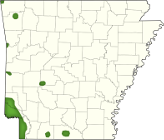Description
This flatly-built, short-tailed lizard is brown or tan in coloration. Darker ⚠ dorsal blotches (often with light borders) and a lighter ⚠ middorsal stripe are present. It is covered in spines, with the most prominent spines on the back of the head. There is also a double row of spines along the fringes of the abdomen.
This species is also known--erroneously--as a Horny Toad or Horned Toad.
Habitats
This is a species of desert habitats. Dry, exposed, sandy areas provide suitable living conditions.
Habits and Life History
This species is most likely to be seen as it basks or forages around ant colonies.
Breeding extends from spring to summer, with females laying multiple clutches of eggs per year. No brooding of the eggs is observed.
Prey and Hunting Techniques
This species is an ant specialist, feeding primarily on harvester ants. After a good bask to warm in the sun, it will dart along in short bursts gulping down ants as they pass by.
Temperament and Defense
This species is faster than one might imagine and will dart away quickly from danger. It is also well camouflaged and may even bury into sandy soil. If captured, one is likely to puff up with air, erecting the spines. As a unique defensive mechanism, this species can squirt blood from its eye ducts. The blood contains a chemical that tastes bad to would-be predators.
Conservation
This species is likely ⚠ extirpated in Arkansas. The last confirmed population was located near Fort Smith in the early 1970's (Trauth et. al. 2004). It is a species considered rare by the Arkansas Natural Heritage Commission and has been identified as a species of greatest conservation need by the Wildlife Conservation Strategy group. It is protected from international trade by CITES Appendix II. It was once an extremely popular lizard of the pet trade and evidence suggests that populations in Arkansas may have been established from illegitimately released stock. Whether or not naturally-occurring populations ever existed in Arkansas is an issue of debate. What is clear, however, is that populations have shown a marked decline in some areas of its former range. The causes of such declines aren't completely understood, but some proposed reasons include changes in land use, overcollection, the overuse of pesticides killing prey-species ants, and the spread of non-native fire ants out-competing native ants.
State Distribution and Abundance

| Spotty, historical records exist for Garland, Sebastian, Sevier, Union, and Washington counties. No recent records exist for the species in Arkansas. Current abundance is presumed to be zero.
|
Gallery
⚠ (:flickrgallery:)
Contributors
- kaptainkory January 08, 2007, at 09:37 PM (Original Contributor)
Bibliography
- Behler, J. L., and F. W. King. 1979 (1987). The Audubon Society Field Guide to North American Reptiles and Amphibians. 3rd ed. Alfred A. Knopf, New York. 743 pp.
- Conant, R., and J. T. Collins. 1998. A Field Guide to Reptiles and Amphibians of Eastern and Central North America. 3rd ed., Expanded. Houghton Mifflin Co., Boston. 616 pp.
- Trauth, S. E., H. W. Robison, and M. V. Plummer. 2004. Amphibians and Reptiles of Arkansas. University of Arkansas Press, Fayetteville. 421 pp.
Discussion
- For what it's worth, I remember as a youngster growing up in Madison County a classmate bringing in a "Horny Toad" for show-and-tell. He (or she?) just had it in a shoe box with tissues. It started bleeding out of its eyes after the kids handled it a bit. I must have been 10 or 12; that would put the date in the early 1980's. I can't offer any more details. I don't remember if the student claimed to have caught it locally or brought it in from "vacation"... ~ kaptainkory January 08, 2007, at 09:37 PM
Discussion
I released several Texas Horned Lizards on our 10 acre property in DeQueen, Arkansas around 1975. They came from Gillespie County (Fredericksburg) Texas. They were thriving & reproducing when we left there in 1978. We spotted several juveniles that obviously weren't part of the original bunch of transplants. I live in Fredericksburg, TX these days & haven't seen a "Horny Toad" in about 15 years. It's probably the only lizard species that is in decline here. I regret ever taking any of them. Catch & release was always the rule of thumb & this was probably the only time I relocated animals away from their original home.